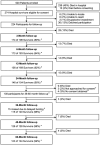Psychiatric symptoms after acute respiratory distress syndrome: a 5-year longitudinal study
- PMID: 29279973
- PMCID: PMC6020022
- DOI: 10.1007/s00134-017-5009-4
Psychiatric symptoms after acute respiratory distress syndrome: a 5-year longitudinal study
Abstract
Purpose: We aimed to characterize anxiety, depression, and posttraumatic stress disorder (PTSD) symptoms over 5-year follow-up after acute respiratory distress syndrome (ARDS) and determine risk factors for prolonged psychiatric morbidity.
Methods: This prospective cohort study enrolled patients from 13 medical and surgical intensive care units in four hospitals, with follow-up at 3, 6, 12, 24, 36, 48, and 60 months post-ARDS. Trained research staff administered the Hospital Anxiety and Depression Scale (HADS) (scores ≥ 8 on anxiety and depression subscales indicating substantial symptoms) and the Impact of Event Scale-Revised (IES-R, scores ≥ 1.6 indicating substantial PTSD symptoms) at each follow-up visit.
Results: Of 196 consenting survivors, 186 (95%) completed HADS and IES-R assessments; 96 (52%) had any continuous or recurring (prolonged) symptoms, and 71 (38%), 59 (32%), and 43 (23%) had prolonged anxiety, depression, and PTSD symptoms, respectively (median total durations 33-39 months, 71-100% of observed follow-up time). Prolonged psychiatric symptoms tended to co-occur across domains; the most common morbidity pattern involved substantial symptoms in all three domains. Worse pre-ARDS mental health, including prior depression and psychological distress in the period immediately preceding ARDS, was strongly associated with prolonged post-ARDS psychiatric morbidity across symptom domains.
Conclusions: Clinically significant and long-lasting symptoms of anxiety, depression, and PTSD are common in the first 5 years after ARDS. In-hospital screening of psychiatric history, including recent anxiety and depression symptoms, may be useful for long-term mental health treatment planning after ARDS.
Keywords: Acute respiratory distress syndrome; Anxiety; Depression; Epidemiology; Patient outcomes; Posttraumatic stress disorder.
Conflict of interest statement
On behalf of all authors, the corresponding author states that there is no conflict of interest.
The authors declare that they have no conflicts of interest.
Figures


References
-
- Hopkins RO, Weaver LK, Pope D, Orme JF, Bigler ED, Larson-Lohr V. Neuropsychological sequelae and impaired health status in survivors of severe acute respiratory distress syndrome. Am J Respir Crit Care Med. 1999;160:50–56. - PubMed
-
- Jackson JC, Pandharipande PP, Girard TD, Brummel NE, Thompson JL, Hughes CG, Pun BT, Vasilevskis EE, Morandi A, Shintani AK, Hopkins RO, Bernard GR, Dittus RS, Ely EW. Depression, post-traumatic stress disorder, and functional disability in survivors of critical illness in the BRAIN-ICU study: a longitudinal cohort study. Lancet Respir Med. 2014;2:369–379. - PMC - PubMed
MeSH terms
Grants and funding
LinkOut - more resources
Full Text Sources
Other Literature Sources
Medical

